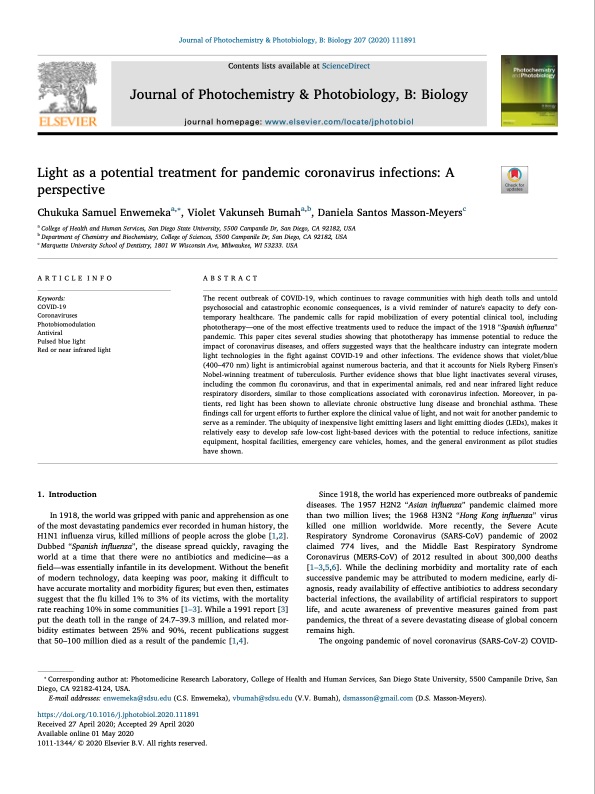
PDF Publication Title:
Text from PDF Page: 002
Journal of Photochemistry & Photobiology, B: Biology 207 (2020) 111891 Contents lists available at ScienceDirect Journal of Photochemistry & Photobiology, B: Biology journal homepage: www.elsevier.com/locate/jphotobiol Light as a potential treatment for pandemic coronavirus infections: A perspective T Chukuka Samuel Enwemekaa,⁎, Violet Vakunseh Bumaha,b, Daniela Santos Masson-Meyersc a College of Health and Human Services, San Diego State University, 5500 Campanile Dr, San Diego, CA 92182, USA b Department of Chemistry and Biochemistry, College of Sciences, 5500 Campanile Dr, San Diego, CA 92182, USA c Marquette University School of Dentistry, 1801 W Wisconsin Ave, Milwaukee, WI 53233. USA ARTICLE INFO Keywords: COVID-19 Coronaviruses Photobiomodulation Antiviral Pulsed blue light Red or near infrared light ABSTRACT The recent outbreak of COVID-19, which continues to ravage communities with high death tolls and untold psychosocial and catastrophic economic consequences, is a vivid reminder of nature's capacity to defy con- temporary healthcare. The pandemic calls for rapid mobilization of every potential clinical tool, including phototherapy—one of the most effective treatments used to reduce the impact of the 1918 “Spanish influenza” pandemic. This paper cites several studies showing that phototherapy has immense potential to reduce the impact of coronavirus diseases, and offers suggested ways that the healthcare industry can integrate modern light technologies in the fight against COVID-19 and other infections. The evidence shows that violet/blue (400–470 nm) light is antimicrobial against numerous bacteria, and that it accounts for Niels Ryberg Finsen's Nobel-winning treatment of tuberculosis. Further evidence shows that blue light inactivates several viruses, including the common flu coronavirus, and that in experimental animals, red and near infrared light reduce respiratory disorders, similar to those complications associated with coronavirus infection. Moreover, in pa- tients, red light has been shown to alleviate chronic obstructive lung disease and bronchial asthma. These findings call for urgent efforts to further explore the clinical value of light, and not wait for another pandemic to serve as a reminder. The ubiquity of inexpensive light emitting lasers and light emitting diodes (LEDs), makes it relatively easy to develop safe low-cost light-based devices with the potential to reduce infections, sanitize equipment, hospital facilities, emergency care vehicles, homes, and the general environment as pilot studies have shown. 1. Introduction In 1918, the world was gripped with panic and apprehension as one of the most devastating pandemics ever recorded in human history, the H1N1 influenza virus, killed millions of people across the globe [1,2]. Dubbed “Spanish influenza”, the disease spread quickly, ravaging the world at a time that there were no antibiotics and medicine—as a field—was essentially infantile in its development. Without the benefit of modern technology, data keeping was poor, making it difficult to have accurate mortality and morbidity figures; but even then, estimates suggest that the flu killed 1% to 3% of its victims, with the mortality rate reaching 10% in some communities [1–3]. While a 1991 report [3] put the death toll in the range of 24.7–39.3 million, and related mor- bidity estimates between 25% and 90%, recent publications suggest that 50–100 million died as a result of the pandemic [1,4]. Since 1918, the world has experienced more outbreaks of pandemic diseases. The 1957 H2N2 “Asian influenza” pandemic claimed more than two million lives; the 1968 H3N2 “Hong Kong influenza” virus killed one million worldwide. More recently, the Severe Acute Respiratory Syndrome Coronavirus (SARS-CoV) pandemic of 2002 claimed 774 lives, and the Middle East Respiratory Syndrome Coronavirus (MERS-CoV) of 2012 resulted in about 300,000 deaths [1–3,5,6]. While the declining morbidity and mortality rate of each successive pandemic may be attributed to modern medicine, early di- agnosis, ready availability of effective antibiotics to address secondary bacterial infections, the availability of artificial respirators to support life, and acute awareness of preventive measures gained from past pandemics, the threat of a severe devastating disease of global concern remains high. The ongoing pandemic of novel coronavirus (SARS-CoV-2) COVID- ⁎ Corresponding author at: Photomedicine Research Laboratory, College of Health and Human Services, San Diego State University, 5500 Campanile Drive, San Diego, CA 92182-4124, USA. E-mail addresses: enwemeka@sdsu.edu (C.S. Enwemeka), vbumah@sdsu.edu (V.V. Bumah), dsmasson@gmail.com (D.S. Masson-Meyers). https://doi.org/10.1016/j.jphotobiol.2020.111891 Received 27 April 2020; Accepted 29 April 2020 Available online 01 May 2020 1011-1344/ © 2020 Elsevier B.V. All rights reserved.PDF Image | Light as a potential treatment for pandemic coronavirus infections

PDF Search Title:
Light as a potential treatment for pandemic coronavirus infectionsOriginal File Name Searched:
covid-vs-light-therapy.pdfDIY PDF Search: Google It | Yahoo | Bing
Cruise Ship Reviews | Luxury Resort | Jet | Yacht | and Travel Tech More Info
Cruising Review Topics and Articles More Info
Software based on Filemaker for the travel industry More Info
The Burgenstock Resort: Reviews on CruisingReview website... More Info
Resort Reviews: World Class resorts... More Info
The Riffelalp Resort: Reviews on CruisingReview website... More Info
| CONTACT TEL: 608-238-6001 Email: greg@cruisingreview.com | RSS | AMP |